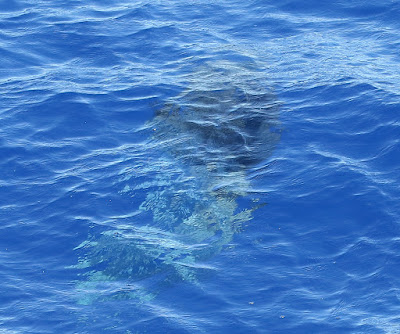We had already had a good selection of Seabirds on the Atlantic Odyssey on the final day at sea before reaching Ascension Island. However, it was a bit of a frustrating day for Cetaceans. Before breakfast we had a pod of distant Dolphins that were too distant & the views too poor to figure what they were. Later, while everybody else was at lunch, I picked up a logging Surfboard, either a Pygmy Sperm Whale or
Dwarf Sperm Whale, about a half mile in front of the ship. Unfortunately,
it close to dive before I could get any photos. Again, the views were too brief to be able to identify it to a species & I was the sole observer. Fortunately, we were more successful with our first party of Striped Dolphins which appeared at the end of breakfast & were around for a few minutes. Having got used to a quick breakfast, I had been back on deck for some time, but a number of people were still eating breakfast & missed them. Still that was their choice to have a leisurely breakfast.
Striped Dolphin: They have a habit of these high jumps as I've also taken photos in Biscay of one doing a similar jump
Striped Dolphin: The thin black stripe is one of the key features for Striped Dolphins. It looks like the back individual is a youngster
After lunch, we were told that we would be passing over a sea mount during the early afternoon. This is effectively an island that never made it to the surface & while the top was probably a few hundred metres below the surface, it was a prominent seabed feature given the seabed would typically be at least two or three kilometres deep. Mountains on land are generally windy & turbulent places. Seamounts are similar with the turbulent sea conditions produce upwellings which bring food & nutrients to the surface. The food & nutrients will attract Fish & other sealife, which in turn provides food for Cetaceans. Around 14:00 we encountered a distant blow of a large Whale, but again it was too far to be sure about its identity. Finally, couple of hours later, two Sperm Whales were found logging (floating & in no hurry to dive) on the surface. Their presence was probably related to the seamount.
Sperm Whale: One of two Sperm Whales that were logging on the surface a few hundred metres from the Plancius
Sperm Whale: Having had the superb close encounter with the Sperm Whales on the previous day, the Expedition Staff decided we would not stop for another close encounter
It was good to see this Sunfish next to the Plancius. It was close to the surface when I picked it up, but it went into a crash dive as the camera was raised.
Sunfish: Honest. I only saw three on the Odyssey & this was the best photo. If you want to see a photo of what they should look like here is a Sunfish I photographed later in the summer on the Portsmouth - Santander ferry
Given the water temperature was 28 degrees, it is no surprise that we saw good numbers of Flying Fish. Although nearly all were Small Clearwings, there were also the larger Mirrorwing Flying Fish & a few Four-winged Flying Fish.
Mirrorwing Flying Fish: I saw around 25 of these during the day
Mirrorwing Flying Fish: Another individual
Small Clearwing (Exocoetus sp.): This was easily the commonest Flying Fish & I saw around 500 during the day
Small Clearwing (Exocoetus sp.): They associate in shoals & when we disturbed a shoal around 30 - 50 would fly out of the sea for a single short glide
One of the other new highlights seen today was my first Portuguese Man-of-war Jellyfish. I carried on seeing a few roughly every other day until we reached Madeira. They are a bizarre Jellyfish with a large pale pink floating sac, with the tentacles dangling under the water.













